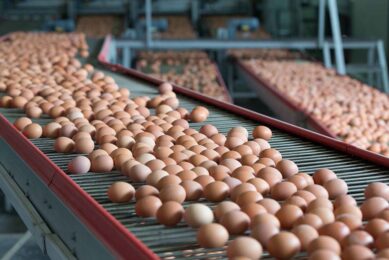Research: Do not make nest floor slope too steep
Researchers from the Swiss Federal Veterinary Office, Centre for Proper Housing: Poultry and Rabbits, in Zollikofen, Switzerland studied the influence of nest-floor slope on the nest choice of laying hens.
Group nests in alternative housing systems for laying hens primarily fulfil the hen’s needs for seclusion and protection.
Commercial nests used in Switzerland are built according to the provisions of the Swiss Animal Welfare Legislation.
However, nest types can differ in aspects, such as floor slope, that could have an impact on egg-laying behaviour.
Floor slope has to be designed so that eggs roll away without breaking and so that hens feel comfortable laying their eggs.
In commercial nests, the slope is usually between 12% and 18%. The aim of this study was to investigate the effect of floor slope on the hen’s nest preference and laying behaviour.
We predicted that hens would prefer nests with a lower sloped floor for evolutionary reasons and for reasons related to comfort.
Trial setup
Eight pens, each with 17–18 white laying hens (LSL), were equipped with two roll-away nests (0.54 m2) having different floor slopes (12% and 18%).
Eggs were collected each day (from approximately 20 weeks of age until 28 weeks of age); the number of eggs in each nest and on the floor of the pens was recorded.
Behaviour inside the nest was filmed for two consecutive days during the main egg-laying time from the second hour to the fifth hour (4 h) after lights came on in week 27/28.
The following data were recorded: number of hens in each nest, the nest visits/egg number ratio, the number of sitting events, the body alignment of hens sitting in the nest and the number and duration of nest visits.
Results
There was no difference between the numbers of eggs in the two nests, but more hens were counted in nests with a 12% slope.
The ratio between the number of nest visits and number of eggs did not differ significantly between the nests. However, we counted more sitting events in the nest with 12% slope.
The percentage of body alignment towards the back and towards the front of the nest differed between the nests.
Furthermore, for nest visits lasting between 10 and 90 min, we found significant differences in the total number of nest visits.
For visits in this range of duration, we also found significant differences for nest visits with sitting and for the number of nest visits with egg laying. All of these differences favoured the 12% nest.
Conclusion
Both nests were generally accepted by the hens. However, because of the higher number of hens counted in the 12% nest and the higher amounts of nest visits and sitting events found in these nests, we recommend to use nests with a floor slope of 12% rather than 18%.
Join 31,000+ subscribers
Subscribe to our newsletter to stay updated about all the need-to-know content in the poultry sector, three times a week. Beheer
Beheer








 WP Admin
WP Admin  Bewerk bericht
Bewerk bericht